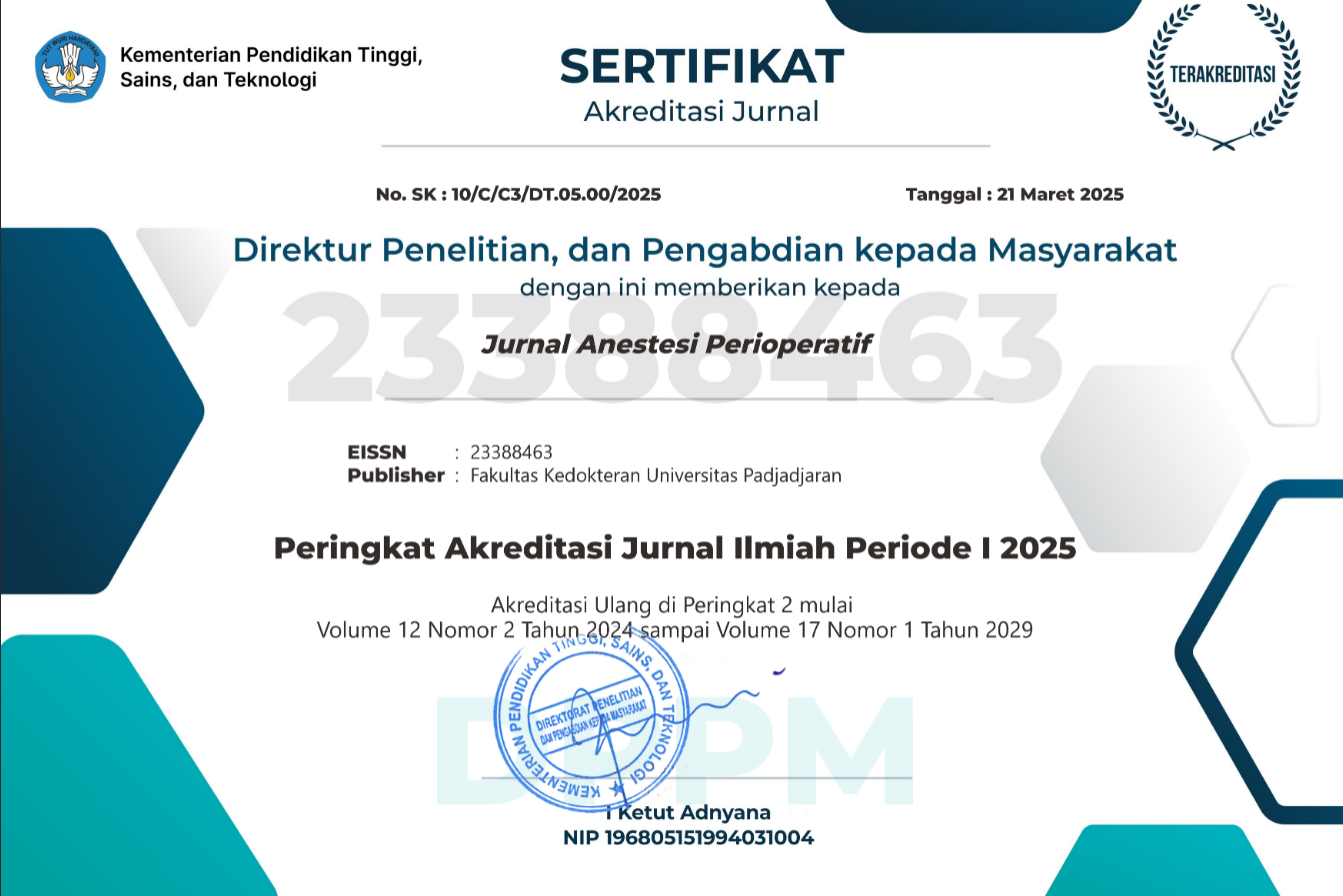Pengaruh Lantunan Ayat Al-Quran terhadap Kebutuhan Opioid Tambahan Pascaseksio Sesarea
Abstract
Lantunan ayat Al-Quran dapat menstimulasi β endorfin yang dihasilkan hipofisis anterior otak. Penelitian ini bertujuan mengetahui pengaruh lantunan ayat Al-Quran terhadap intensitas nyeri dan kebutuhan opioid tambahan pascaseksio sesarea dengan regional spinal. Metode penelitian adalah eksperimental secara acak terkontrol buta tunggal pada 32 ibu hamil berusia >18 tahun dan beragama islam di RSUP Dr. Hasan Sadikin Bandung pada bulan April–Mei 2019. Data jumlah penggunaan opioid tambahan pascaoperasi selama 24 jam yang diberikan dengan patient controlled analgesia (PCA) dianalisis dengan Uji Mann-Whitney. Hasil perhitungan statistik diperoleh penggunaan opioid tambahan pada kelompok lantunan Al-Quran lebih sedikit dibanding dengan kelompok kontrol (21,87 mcg vs 107,87 mcg) dengan perbedaan yang sangat bermakna (p<0,0001). Simpulan penelitian ini menunjukkan bahwa lantunan ayat Al-Quran sebagai terapi tambahan penatalaksanaan nyeri pascaseksio sesarea menurunkan penggunaan opioid tambahan.
Effect of Quran Recital on Additional Opioid Requirement in Post-Cesarean Section
The recitation of Al-Quran could stimulate β endorfins which is produced by anterior pituitary. This study aimed to identify the effect of listening to Al-Quran recitation on pain intensity and additional opioid requirement in patients after spinal cesarean section surgery. This was a randomized single blind controlled experiment on 32 pregnant moslem women over 18 years old treated in Dr. Hasan Sadikin General Hospital Bandung in April 2019-May 2019. The amount of additional 24-hours post-operative opioid requirement using Patient Controlled Analgesia (PCA) was analyzed by the Mann-Whitney Test. Results showed that the use of additional fentanyl in the Al-Quran recitation group was significantly less than in the controlled group(21.87 mcg vs 107.87 mcg) (p<0.0001). Therefore, Al-Quran recitation as an additional therapy in the management of pain is able to reduce the dose of additional fentamyl needed in postcaesarean section patients.
Keywords
Full Text:
PDFReferences
Gadsen JM, Hart S, Santos AC. Post caesarean delivery analgesia. Anesth Analg. 2013;1(10):62–8.
Nurhayati NA, Andriyani S, Malisa N. Relaksasi autogenik terhadap penurunan skala nyeri pada ibu post operasi sectio saecarea. Jurnal Skolastik Keperawatan. 2015;1(2):52–61.
Patel NB. Physiology of pain. Dalam: Kopf A, Patel NB, penyunting. Guide to management in low resource settings. Seattle: International Association for the Study of Pain; 2010. hlm. 13–7.
Meissner W, Coluzzi F, Fletcher D, Huygen F, Morlion B, Neugebauer E, dkk. Improving the management of postoperative acute pain: priorities for change. Curr Med Res Opin. 2015;31(11):2131–43.
Stoelting RK. Pharmacology & physiology in anesthetic practice. 2012;(4):87–122.
Babaii A, Abbasinia M, Hejazi SF, Tabaei SRS, Dehghani F. The effect of listening to voice of quran on anxiety before cardiac catheterization: a randomized controlled trial. Health, Spiritual Med. Ethics. 2015;(2):8–14.
Cully J, Teten A. A therapist’s guide to brief cognitive behavioral theraphy. Houston: Departement of Veterans Affair South Central. MIRECC. 2008;1:6–7.
Elfawal S, Mona R. The effect of quran therapy on sedative requirements and hemodynamic parameters in patients subjected to spinal anesthesia. J Anaesth Pain Med. 2016;1(2):1–4.
Stratton SA. Role of endophins in pain modulation. J Orthop Sports Phys Ther. 1982;3(4):200–5.
Merenlender-Wagner A, Dikshtein Y, Yadid G. The β Endorfin role in stress related psychiatric disorders. Curr Drug Target. 2009;2009(10):1096–108.
Beiranvand S, Noaparast M, Eslamizade N, Saeedikia S. The effects of religion and spiritualism postoperative pain, hemodynamic functioning and anxiety after cesaream section. Acta Medica Iranica. 2014;52(12):909–15
Wahida S, Nooryanto M, Andarini S. Terapi murotal quran surat Arrahman peningkatkan kadar β-endorfin dan menurunkan intensitas nyeri pada ibu bersalin kala I fase aktif. JKB. 2015;28(3):213–6.
Okifuji A, Hare B. The Association between chronic pain and obesity. J Pain Res. 2015;8:399–408.
Lanitis S, Mimigianni C, Raptis D, Sourtse G, Sgourakis G, Karoliotas C. The impact in educational status on postoperative perception of pain. Korean J Pain. 2015;28(4):265–74.
Haryani A, Arifudin, Nurhayati. Prayer and dhikr as spiritual-related interventions for reducing postsurgery pain intensity in moslem’s patients. Int J Res Med Sci. 2015;3(1):30–5.
Benarroch EE. Endogenous opioid systems: current concepts and clinical correlation. J Am Acad Neurol. 2012;79(807):107–13.
Sprouse Blum AS, Smith G, Sugai D, Parsa FD, Understanding endhorphine and importance in pain management. Hawai Med J Anaesth. 2010;69(1):8–11.
Khan N, Abdalla AN, Beg A, Wahab NM. Mental and spiritual relaxation by recitation of the holy quran. Second Int Conference on Computer Res Dev. 2010:863–7.
Kaufman E, Epstein JB, Gorsky M, Jackson DL, Kadari A. Preemtive analgesia and local anesthesia as supplement to general anesthesia: A Riview. Anesth Prog. 2013;10(01):757–70.
Bandeira RA, Gomes L, Bezerra AJC, Duarte JA. Correlation between preoperative anxiety and acute postoperative pain in eldery patient submitted to transvesical prostatectomy. Rev Dor Sao Paulo. 2017;18(4):291–6.
DOI: https://doi.org/10.15851/jap.v7n2.1756
Article Metrics
Abstract view : 1295 timesPDF - 407 times
This Journal indexed by

JAP is licensed under a Creative Commons Attribution-NonCommercial 4.0 International License
View My Stats



